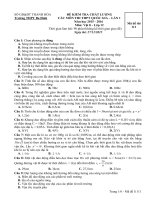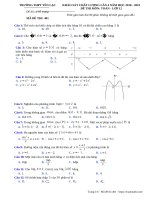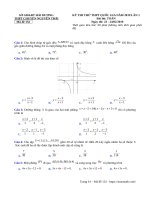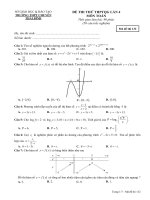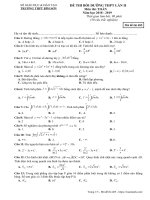Tải Ôn thi THPT Quốc gia năm 2019 môn Tiếng Anh số 31 - Đề thi thử THPTQG năm 2019 môn Tiếng Anh cô Quỳnh Trang có đáp án
Bạn đang xem bản rút gọn của tài liệu. Xem và tải ngay bản đầy đủ của tài liệu tại đây (115.55 KB, 11 trang )
<span class='text_page_counter'>(1)</span><div class='page_container' data-page=1>
<b>ĐỀ LUYỆN THI THPT QUỐC GIA MÔN TIẾNG ANH</b>
<b>NĂM 2019 CÓ ĐÁP ÁN</b>
<i><b>Mark the letter A, B, C, or D on your answer sheet to indicate the word whose underlined</b></i>
<i><b>part differs from the other three in pronunciation in each of the following questions. </b></i>
<b>Question 1: A. family </b> <b>B. famine </b> <b>C. famous </b> <b>D. fabricate </b>
<b>Question 2: A. pension </b> <b>B. vision </b> <b>C. pleasure </b> <b>D. measure </b>
<i><b>Mark the letter A, B, C, or D on your answer sheet to indicate the word that differs from</b></i>
<i><b>the other three in the position of primary stress in each of the following questions. </b></i>
<b>Question 3: A. occur </b> <b>B. prefer </b> <b>C. apply </b> <b>D. surface </b>
<b>Question 4: A. domination </b> <b>B. adventure </b> <b>C. grammatical </b> <b>D. emergency </b>
<i><b>Mark the letter A, B, C, or D on your answer sheet to indicate the underlined part that</b></i>
<i><b>needs correction in the each of following questions</b></i>.
<b>Question 5: They had a discussion about training not only the new employees but also</b>
giving them some challenges.
<b>A. about </b> <b>B. training not only </b> <b>C. giving </b> <b>D. some challenges </b>
<b>Question 6: The University of Kentucky has held this prestigious title until 1989, when it</b>
was granted to the University of Georgia
<b>A. has held </b> <b>B. it </b> <b>C. was granted </b> <b>D. to </b>
<b>Question 7: They are the shocking news in newspapers that is what people are talking about</b>
this morning.
<b>A. They are </b> <b>B. is </b> <b>C. are </b> <b>D. about </b>
</div>
<span class='text_page_counter'>(2)</span><div class='page_container' data-page=2>
<b>Question 8: _______ in large quantities in the Middle East, oil became known as black gold</b>
because of the large profit it brought.
A. That when discovered <b>B. Discovered </b>
<b>C. Discovering </b> <b>D. Which was discovered </b>
<b>Question 9: I like doing _______ such as cooking, washing and cleaning the house. </b>
<b>A. house-keeper B. household chores C. lord of house </b> <b>D. white house </b>
<b>Question 10: The scientists _______ on this project try to find the solutions to air pollution. </b>
<b>A. working </b> <b>B. worked </b> <b>C. are working </b> <b>D. who working </b>
<b>Question 11: Susan rarely stays up late, _______? </b>
<b>A. is she </b> <b>B. isn’t she </b> <b>C. does she </b> <b>D. doesn’t she </b>
<b>Question 12: Why not _______ the meeting until Thursday morning? </b>
<b>A. postpone </b> <b>B. postponing </b> <b>C. you postpone </b> <b>D. do you postpone </b>
<b>Question 13: I must warn you I am not used to _______ so rudely. </b>
<b>A. speak </b> <b>B. be spoken </b> <b>C. speak to me </b> <b>D. being spoken to </b>
<b>Question 14: Flat-roofed buildings are not very _______ in areas where there is a great deal</b>
of rain or snow.
<b>A. severe </b> <b>B. serious </b> <b>C. suitable </b> <b>D. sensitive </b>
<b>Question 15: I _______ Lan since she went abroaD. </b>
<b>A. wasn’t met </b> <b>B. hadn’t met </b> <b>C. didn’t meet </b> <b>D. haven’t met </b>
<b>Question 16: That carcinogenic substances _______ in many common household items is</b>
well-known.
</div>
<span class='text_page_counter'>(3)</span><div class='page_container' data-page=3>
<b>Question 17: As a small boy, he used to _______ alone in the house for an hour or two. </b>
<b>A. being left </b> <b>B. leaving </b> <b>C. be left </b> <b>D. leave </b>
<b>Question 18: The trouble with James is that he never _______ on time for a meeting. </b>
<b>A. turns up</b> <b>B. takes off </b> <b>C. takes up </b> <b>D. turns down </b>
<b>Question 19: That style of dress _______ have been designed by Titian, because it wasn’t</b>
worn till after his death.
<b>A. must </b> <b>B. might </b> <b>C. can’t </b> <b>D. shouldn’t </b>
<i><b>Mark the letter A, B, C, or D on your answer sheet to indicate the most suitable response</b></i>
<i><b>to complete each of the following exchanges. </b></i>
<b>Question 20: Mr. Collin: “You’ve been making very good progress. I’m proud of you!” </b>
-Brian: “_______”
<b>A. No problem. </b> <b>B. Don’t worry about it! </b>
<b>C. Everything’s alright. Thank you. </b> <b>D. I really appreciate you saying that. </b>
<b>Question 21: Nam: “I think it is a good idea to have three or four generations living under</b>
one roof.” - Mai: “_______. Family members can help each other a lot.”
<b>A. I don’t agree </b> <b>B. It’s not true C. That’s wrong D. I couldn't agree more </b>
<i><b>Mark the letter A, B, C, or D on your answer sheet to indicate the word(s) CLOSEST in</b></i>
<i><b>meaning to the underlined word(s) in each of the following questions. </b></i>
<b>Question 22: In the twentieth century, drug markedly improved health throughout the</b>
world
</div>
<span class='text_page_counter'>(4)</span><div class='page_container' data-page=4>
<b>A. honest </b> <b>B. dedicated </b> <b>C. polite </b> <b>D. lazy </b>
<i><b>Mark the letter A, B, C, or D on your answer sheet to indicate the word(s) OPPOSITE in</b></i>
<i><b>meaning to the underlined word(s) in each of the following questions. </b></i>
<b>Question 24: Those who advocate for doctor-assisted suicide say the terminally ill should</b>
not have to suffer.
<b>A. support </b> <b>B. oppose </b> <b>C. annul </b> <b>D. convict </b>
<b>Question 25: The investigation revealed some rather unexpected results. </b>
<b>A. predictable </b> <b>B. positive </b> <b>C. surprising </b> <b>D. impressive</b>
<i><b> Mark the letter A, B, C, or D on your answer sheet to indicate the sentence that is closest</b></i>
<i><b>in meaning to each of the following questions. </b></i>
<b>Question 26: Although he was able to do the job, he wasn’t given the position. </b>
<b>A. Because he couldn’t do the job, he wasn’t given the position. </b>
<b>B. The position wasn’t given to him in spite of his ability to do the job</b>
<b>C. He got the position despite being unable to do the job</b>
<b>D. He was given neither the job nor the position </b>
<b>Question 27: He broke my watch. </b>
<b>A. My watch were broken. </b> <b>B. My watch be broken. </b>
<b>C. My watch is broken. </b> <b>D. My watch was broken. </b>
<b>Question 28: A child is influenced as much by his schooling as by his parents. </b>
</div>
<span class='text_page_counter'>(5)</span><div class='page_container' data-page=5>
<b>D. A child's schooling influences him as much as his parents do. </b>
<i><b>Mark the letter A, B, C, or D on your answer sheet to indicate the sentence that best</b></i>
<i><b>combines each pair of sentences in the following questions. </b></i>
<b>Question 29: I didn’t arrive in time. I was not able to see her off. </b>
<b>A. I arrived very late to say goodbye to her. </b>
<b>B. She had left because I was not on time. </b>
<b>C. I was not early enough to see her off. </b>
<b>D. I didn’t go there, so I could not see her off. </b>
<b>Question 30: I understand why you detest her. I’ve finally met her. </b>
<b>A. I understand why you don’t like her due to I’ve lastly met her. </b>
<b>B. Now that I have finally met her, I understand why you hate her. </b>
<b>C. I met her and I know your feeling. </b>
<b>D. Since I finally met her, I understand why you like her. </b>
<i><b>Read the following passage and mark the letter A, B, C, or D on your answer sheet to</b></i>
<i><b>indicate the correct word or phrase that best fits each of the numbered blanks from 31 to</b></i>
<i><b>35. </b></i>
</div>
<span class='text_page_counter'>(6)</span><div class='page_container' data-page=6>
The most successful animals on earth - human beings - will soon be the only ones (35)
_______, unless we can solve this problem.
<b>Question 31: A. threat</b> <b>B. problem</b> <b>C. danger</b> <b>D. vanishing</b>
<b>Question 32: A. disappeared</b> <b>B. vanished</b> <b>C. extinct</b> <b>D. empty</b>
<b>Question 33: A. for life</b> <b>B. alive</b> <b>C. lively</b> <b>D. for living</b>
<b>Question 34: A. spoil</b> <b>B. wound</b> <b>C. wrong</b> <b>D. harm</b>
<b>Question 35: A. lef</b> <b>B. Over</b> <b>C. staying</b> <b>D. survive</b>
<i><b>Read the following passage and mark the letter A, B, C, or D on your answer sheet to</b></i>
<i><b>indicate the correct answer to each of the questions from 36 to 42. </b></i>
A large number of inventions require years of <i><b>arduous</b></i> research and development before
they are perfected. For instance, Thomas Edison had to make more than 1,000 attempts to
invent the incandescent light bulb before he finally succeeded. History is replete with
numerous other examples of people trying, yet failing to make inventions before they
eventually succeeded. Yet some inventions have come about not through hard work but
simply by accident.
In most cases, when someone unintentionally invented something, the inventor was
attempting to create something else. For example, in the 1930s, chemist Roy Plunkett was
attempting to make a new substance that could be used to refrigerate items. He mixed some
chemicals together. Then, he put them into a pressurized container and cooled the mixture.
By the time his experiment was completed, he had a new invention. It was not a new
substance that could be used for refrigeration though. Instead, he had invented Teflon, which
is today most commonly used to make nonstick pots and pans. Similarly, decades earlier,
John Pemberton was a pharmacist in Atlanta, Georgia .He was attempting to create a tonic
that people could use whenever they had headaches. While he was not successful in that
</div>
<span class='text_page_counter'>(7)</span><div class='page_container' data-page=7>
Scientists have also made crucial discoveries by accident when they were conducting
experiments. In 1928, Alexander Fleming discovered penicillin, an antibiotic, in this manner.
He discovered some mold growing in a dish with some bacteria. He noticed that the bacteria
seemed to be avoiding the mold. When he investigated further, he determined some of the
many useful properties of penicillin, which has saved millions of lives over the past few
decades. Likewise, in 1946, scientist Percy Spencer was conducting an experiment with
microwaves. He had a candy bar in his pocket, and he noticed that it suddenly melted. He
investigated and learned the reason why that had happened. Soon afterward, he built a device
that could utilize microwaves to heat food: the microwave oven.
<b>Question 36: Which title best summarizes the main idea of the passage? </b>
<b>A. History's Most Important Inventions </b>
<b>B. Accidental Inventions and Discoveries </b>
<b>C. How to Become a Great Inventor </b>
<b>D. You Don't Always Get What You Want </b>
<b>Question 37: In paragraph 1, the word “arduous” is closest in meaning to _______. </b>
<b>A. detailed </b> <b>B. tough </b> <b>C. specific </b> <b>D. constant </b>
<b>Question 38: In paragraph 2, the word “endeavor” is closest in meaning to _______. </b>
<b>A. research </b> <b>B. dream </b> <b>C. request </b> <b>D. attempt </b>
<b>Question 39: What does the author say about Teflon? </b>
</div>
<span class='text_page_counter'>(8)</span><div class='page_container' data-page=8>
<b>Question 40: Who was John Pemberton? </b>
<b>A. The person who made Teflon </b>
<b>B. The creator of Coca-Cola </b>
<b>C. The man who discovered penicillin </b>
<b>D. The inventor of the microwave </b>
<b>Question 41: The author uses Alexander Fleming as an example of _______. </b>
<b>A. one of the most famous inventors in history </b>
<b>B. a person who made an accidental scientific discovery </b>
<b>C. someone who became a millionaire from his invention </b>
<b>D. a man who dedicated his life to medical science </b>
<b>Question 42: What does the author imply about penicillin? </b>
<b>A. Doctors seldom use it nowadays. </b>
<b>B. Some people are not affected by it. </b>
<b>C. It is an invaluable medical supply. </b>
<b>D. Mold combines with bacteria to make it. </b>
<i><b>Read the following passage and mark the letter A, B, C, or D on your answer sheet to</b></i>
<i><b>indicate the correct answer to each of the questions from 43 to 50. </b></i>
</div>
<span class='text_page_counter'>(9)</span><div class='page_container' data-page=9>
or wood suggests, perhaps even dictates, not only the ultimate form, but even the subject
matter.
The technique of direct carving was a break with the nineteenth-century tradition in
which the making of a clay model was considered the creative act and the work was then
turned over to studio assistants to be cast in plaster or bronze or carved in marble.
Neoclassical sculptors seldom held a mallet or chisel in their own hands, readily conceding
that the assistants they employed were far better than they were at carving.
With the turn-of-the-century Crafts movement and the discovery of nontraditional
sources of inspiration, such as wooden African figures and masks, there arose a new urge for
hands-on, personal execution of art and an interaction with the medium. Even as early as the
1880's and 1890's, nonconformist European artists were attempting direct carving. By the
second decade of the twentieth century, Americans - Laurent and Zorach most notably - had
adopted it as their primary means of working.
Born in France, Robert Laurent (1890-1970) was a prodigy who received his education
in the United States. In 1905 he was sent to Paris as an apprentice to an art dealer, and in the
years that followed he witnessed the birth of Cubism, discovered primitive art, and learned
the techniques of woodcarving from a frame maker.
Back in New York City by 1910, Laurent began carving pieces such as The Priestess,
which reveals his fascination with African, pre-Columbian, and South Pacific art. Taking a
walnut plank, the sculptor carved the expressive, stylized design.
It is one of the earliest examples of direct carving in American sculpture. The plank's
form dictated the rigidly frontal view and the low relief. Even its irregular shape must have
appealed to Laurent as a break with a long-standing tradition that required a sculptor to
work within a perfect rectangle or square.
</div>
<span class='text_page_counter'>(10)</span><div class='page_container' data-page=10>
<b>A. A sculptor must work with talented assistants. </b>
<b>B. The subject of a sculpture should be derived from classical stories. </b>
<b>C. The material is an important element in a sculpture. </b>
<b>D. Designing a sculpture is a more creative activity than carving it. </b>
<b>Question 45: The word “dictates” in paragraph 1 is closest in meaning to _______. </b>
<b>A. includes </b> <b>B. determines </b> <b>C. reads aloud </b> <b>D. records </b>
<b>Question 46: How does direct carving differ from the nineteenth-century tradition of</b>
sculpture?
<b>A. Sculptors are personally involved in the carving of a piece. </b>
<b>B. Sculptors find their inspiration in neoclassical sources. </b>
<b>C. Sculptors have replaced the mallet and chisel with other tools. </b>
<b>D. Sculptors receive more formal training. </b>
<b>Question 47: The word “witnessed” in paragraph 4 is closest in meaning to _______. </b>
<b>A. studied </b> <b>B. influenced </b> <b>C. validated </b> <b>D. observed </b>
<b>Question 48: Where did Robert Laurent learn to carve? </b>
<b>A. The South Pacific </b> <b>B. Paris </b> <b>C. Africa </b> <b>D. New York </b>
<b>Question 49: The phrase “a break with” in paragraph 6 is closest in meaning to _______. </b>
<b>A. a solution to </b> <b>B. a collapse of </b> <b>C. a destruction of </b> <b>D. a departure from </b>
<b>Question 50: The piece titled The Priestess has all of the following characteristics EXCEPT</b>
_______.
</div>
<span class='text_page_counter'>(11)</span><div class='page_container' data-page=11>
<b>ĐÁP ÁN</b>
</div>
<!--links-->
